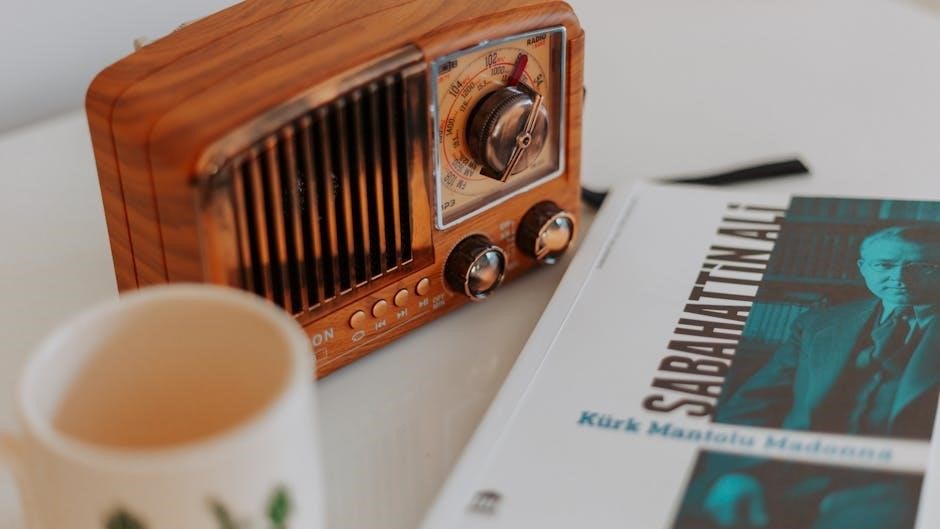This book serves as a comprehensive guide, showcasing an extensive collection of radio models ever made. It documents each model’s history, design, and technological significance, catering to enthusiasts, collectors, and historians alike.
What is the Book About
The book is an extensive catalog detailing all radio models ever made, providing a comprehensive overview of their history, design, and technological evolution. It covers early vintage radios, mid-century designs, and modern innovations, offering insights into their development and cultural impact. The text includes detailed descriptions, images, and specifications, making it a valuable resource for collectors, historians, and radio enthusiasts. Organized chronologically and by brand, the book highlights iconic models and their contributions to broadcasting. It also explores the transition from analog to digital technologies, showcasing how radios have adapted to modern demands. This guide serves as both a historical archive and a practical reference for understanding the diverse world of radio technology.
Importance of Documenting Radio Models
Documenting radio models is crucial for preserving the history of broadcasting and communication technology. This comprehensive archive ensures that the evolution of radios, from early prototypes to modern innovations, is recorded for future generations. By cataloging each model’s design, functionality, and historical context, the book provides a valuable resource for researchers, collectors, and historians. It also highlights the significance of radios in shaping global communication and culture.
Such documentation aids in understanding technological advancements and their societal impact, making it an essential tool for education and innovation. The book serves as a testament to human ingenuity and the enduring importance of radio technology in connecting the world.

Historical Overview
This section explores the journey of radio technology from its invention in the late 1800s to modern times, highlighting milestones and innovations that shaped its development.
Early Days of Radio
The early days of radio began with experiments by pioneers like Guglielmo Marconi, who successfully transmitted wireless signals over long distances in the late 1800s. The first radios were bulky, relying on crystal detectors and basic tuning circuits. These early models were primarily used for military and maritime communication. As technology advanced, vacuum tubes replaced crystals, improving sensitivity and range. The 1920s marked the rise of radio broadcasting, with stations emerging worldwide. This era laid the foundation for modern radio, transforming it from a niche tool into a popular medium for entertainment and information. The evolution during these formative years set the stage for the diverse radio models that followed.
Evolution Over the Years
Radio technology has undergone remarkable transformations since its inception. Early models relied on vacuum tubes, which were bulky and prone to overheating. The mid-20th century introduced transistor radios, offering portability and efficiency. The 1970s saw the rise of integrated circuits, further miniaturizing radios. Digital technology emerged in the 1990s, enabling better sound quality and features like AM/FM presets. Modern radios incorporate advanced technologies such as HD Radio, Bluetooth connectivity, and internet streaming. This evolution reflects continuous innovation, adapting to changing listener needs and technological advancements. Each era brought significant improvements, transforming radios from static-prone devices into sophisticated entertainment systems. The journey highlights human ingenuity in refining communication tools.

Radio Models by Era
This section explores vintage, mid-century, modern, and contemporary radio models, highlighting their unique designs, technological advancements, and cultural impact across different time periods.
Vintage Radio Models
Vintage radio models, spanning from the early 20th century to the mid-1950s, are celebrated for their intricate craftsmanship and nostalgic appeal. These radios, often designed with ornate wood cabinetry and art deco details, were not only functional but also served as decorative pieces in homes. Early models like the cathedral radio and console radio exemplified the blend of technology and artistry. The development of AM radio dominated this era, with brands like Philco and RCA leading the way. Vintage radios are now highly sought after by collectors for their historical significance and retro charm, offering a glimpse into the evolution of broadcasting technology and design aesthetics. Many of these models have been meticulously restored to preserve their original character and functionality, making them timeless treasures for enthusiasts.
Mid-Century Radio Models
Mid-century radio models, spanning the 1940s to the 1960s, reflect a blend of modern design and advancing technology. Post-WWII innovations brought affordable, compact radios to the masses, featuring sleek, minimalist designs in materials like plastic and chrome. This era saw the rise of portable radios, car radios, and the introduction of FM broadcasting. Brands like Zenith and RCA pioneered these changes, offering models with improved sound quality and user-friendly controls. The mid-century period also marked the transition from bulky, ornate designs to sleek, futuristic aesthetics, capturing the spirit of the “space age.” These radios are now prized by collectors for their nostalgic appeal and historical significance, bridging the gap between vintage and modern technologies.
Modern Era Radio Models
Modern era radio models, from the late 20th century onward, emphasize digital technology and connectivity. These radios often feature Wi-Fi, Bluetooth, and smartphone app integration, enabling streaming and multi-room audio. Touchscreens, voice assistants, and HD radio capabilities are common, enhancing user experience. Energy efficiency and sleek designs cater to contemporary lifestyles. Brands like Sonos and Bose lead innovation, blending traditional radio with modern smart home systems. This era also sees a focus on sustainability, with eco-friendly materials and energy-saving modes. The modern radio combines nostalgia with cutting-edge tech, appealing to both retro enthusiasts and tech-savvy users. These models redefine radio’s role in the digital age.
Contemporary Radio Models
Contemporary radio models represent the pinnacle of innovation, blending advanced technology with sleek designs. These radios often feature AI integration, voice control, and seamless connectivity to smart home systems. With Wi-Fi and Bluetooth capabilities, users can access countless streaming services and enjoy multi-room audio. High-resolution audio support and customizable EQ settings cater to audiophiles. Many contemporary radios also include USB ports for direct playback and charging. Energy efficiency is a key focus, with models incorporating low-power modes and sustainable materials. These radios are not just devices but integral parts of modern lifestyles, offering unparalleled versatility and convenience. They exemplify how radio has evolved to remain relevant in the digital age.
Radio Models by Brand
This section highlights major radio brands like Sony, Panasonic, and Philips, showcasing their iconic models, design evolution, and technological advancements that shaped the industry over decades.
Major Radio Brands
The book extensively covers major radio brands such as Sony, Panasonic, Philips, and Zenith, providing insights into their historical significance and contributions to radio technology. These brands have shaped the industry through innovative designs and groundbreaking features. For instance, Sony revolutionized portable radios with its iconic models, while Panasonic focused on durability and affordability. Philips introduced advanced tuning mechanisms, enhancing user experience. Zenith, known for its high-quality receivers, played a pivotal role in the golden age of radio. The book highlights how these brands adapted to technological advancements, ensuring their legacy in the evolution of radio technology. Each brand’s story is told through detailed descriptions of their most notable models and their impact on the market.
Notable Models from Each Brand
The book highlights iconic models from leading brands, showcasing their unique contributions. Sony’s TR-63, the world’s first portable transistor radio, revolutionized portability. Panasonic’s RF-5000 became a benchmark for durability and sound quality. Philips’ Philetta introduced the concept of a portable, battery-powered radio. Zenith’s Trans-Oceanic series, known for its advanced shortwave capabilities, remains a collector’s favorite. Each model’s design, features, and historical impact are detailed, providing a comprehensive view of how these brands shaped the radio industry.
Types of Radios
The book categorizes radios into distinct types, including AM/FM, shortwave, ham, and internet radios. Each type serves unique purposes, offering varied functionalities for diverse listening experiences and applications.
AM/FM Radios
AM/FM radios are the most common type of broadcast receivers, offering access to local stations on both amplitude modulation (AM) and frequency modulation (FM) bands. Known for their simplicity and reliability, these radios provide high-quality audio for music, news, and talk shows. The book details the evolution of AM/FM radios, from vintage models with analog dials to modern digital versions with preset features. It highlights iconic designs, such as the transistor radio, which revolutionized portability in the mid-20th century. Additionally, the book explores advancements like stereo FM and HD Radio, showcasing how AM/FM radios remain essential in today’s multimedia landscape, blending tradition with innovation.
Shortwave Radios
Shortwave radios operate on frequencies between 2-30 MHz, enabling long-distance communication across continents. Ideal for hobbyists and international listeners, these radios often feature multiple frequency bands and advanced tuning options. The book highlights iconic shortwave models, such as the Sony ICF-SW7600GR, known for their durability and reception quality. It also explores modern shortwave radios with digital interfaces and DSP (Digital Signal Processing) for improved clarity. Whether for monitoring global broadcasts or emergency communications, shortwave radios remain indispensable tools. The book provides a detailed overview of their history, design, and functionality, making it a must-have resource for enthusiasts and professionals alike.
Ham Radios
Ham radios, used by amateur radio operators, enable two-way communication worldwide. These radios operate across various frequency bands, supporting modes like SSB, CW, and digital. The book features iconic models such as the Yaesu FT-1000D and Icom IC-756Pro, known for their advanced capabilities. Modern ham radios often include DSP, touchscreens, and Wi-Fi connectivity for remote operation. They cater to hobbyists, emergency responders, and enthusiasts, fostering global communication and innovation. The book details their evolution, technical specifications, and cultural impact, making it a vital resource for anyone interested in amateur radio technology and its role in connecting communities worldwide.
Internet Radios
Internet radios stream audio content via the internet, offering access to thousands of global stations, podcasts, and on-demand content. Models like the Logitech Squeezebox and Grace Digital Mondo combine traditional radio features with digital capabilities. These radios often include multi-room audio support, smartphone app control, and integration with voice assistants like Alexa. They eliminate the need for antennas and tuning, providing crisp, high-quality sound. The book highlights how internet radios have revolutionized listening habits, blending modern technology with the nostalgia of radio broadcasting. With their sleek designs and advanced features, internet radios represent a significant evolution in home audio entertainment.
Features and Technologies
The book explores various features and technologies, from analog tuning to digital displays, smart radio apps, and voice control, enhancing the listening experience across all radio models.
Analog vs Digital Radios
Analog radios rely on traditional tuning dials, offering a nostalgic listening experience with a warm, natural sound. They often feature simple, intuitive controls and are prized for their classic design. However, analog radios can be susceptible to signal interference and may lack the precision of modern alternatives. Digital radios, in contrast, provide crisp, clear sound with advanced features like preset buttons, AM/FM modes, and digital displays. They eliminate static and offer better signal stability, making them ideal for modern listeners. The book highlights how both types have evolved over time, catering to different preferences and needs, ensuring a place for each in the world of radio enthusiasts.
Smart Radio Features
Smart radios integrate cutting-edge technology, offering features like voice control via assistants such as Alexa or Google Assistant. They often come with Wi-Fi connectivity, enabling access to internet radio stations worldwide. Users can stream content via Bluetooth or apps, creating a seamless listening experience. Advanced models include multi-room audio capabilities, allowing synchronization across devices. Touchscreens, programmable presets, and customizable EQ settings further enhance functionality. These radios also support podcast playback and smart home integration, blending traditional radio with modern convenience. The book explores how these innovations redefine radio listening, catering to tech-savvy users while preserving the charm of analog designs.

Design and Collectibility
This section explores the evolution of radio design, from vintage aesthetics to modern minimalism, highlighting what makes certain models truly collectible and historically significant.
Design Evolution
The design evolution of radios reflects technological advancements and changing aesthetics over the decades. Early models featured ornate wooden cabinets and analog dials, emphasizing craftsmanship and functionality. As technology progressed, mid-century designs embraced modernist principles, with sleek lines and minimalistic profiles; The shift to plastic materials in the mid-20th century allowed for vibrant colors and more affordable production. Contemporary radios often blend retro elements with modern touches, such as digital displays and touch controls. This chapter highlights how radio design has adapted to cultural trends, user needs, and innovations in electronics, showcasing the journey from bulky, functional devices to sleek, multifunctional entertainment hubs.
Collectible Models
Certain radio models have become highly sought after by collectors due to their rarity, historical significance, or unique design. Vintage radios from the early 20th century, such as cathedral radios, are particularly coveted for their intricate craftsmanship and art deco styling. Mid-century transistor radios, known for their portability and sleek designs, are also treasured by enthusiasts. Limited-edition models and those associated with notable events or personalities further enhance their collectible value. The condition, originality, and functionality of these radios play a crucial role in determining their worth. Collectors often cherish these pieces as a connection to the past, blending nostalgia with technological heritage.

Applications of Radios
Radios serve various purposes, from emergency communication to entertainment. Portable radios offer mobility, while home systems provide immersive sound. Car radios enhance in-transit experiences, and modern models integrate smart features.
Portable Radios
Portable radios are designed for mobility, offering convenience and accessibility. They are ideal for outdoor activities, travel, or emergency situations. Many models are battery-powered, ensuring reliability without electricity. These radios often feature compact designs, durable construction, and user-friendly interfaces. Advanced models include additional functionalities like USB charging, Bluetooth connectivity, and waterproofing. Portable radios cater to diverse needs, from camping enthusiasts to emergency responders. Their versatility makes them a popular choice for everyday use and crisis scenarios. With a wide range of styles and technologies available, portable radios remain essential tools for staying connected on the go. Their practicality and adaptability continue to make them indispensable in modern life.
Home Stereo Systems
Home stereo systems are designed to deliver high-quality audio for indoor entertainment. These systems typically include components like amplifiers, speakers, and tuners, offering immersive sound experiences. Many models feature sleek designs, blending seamlessly into home décor while providing advanced features such as wireless connectivity and multi-room audio capabilities. Vintage systems often emphasize analog purity, while modern versions integrate digital technologies like Wi-Fi and voice control. Home stereo systems cater to audiophiles and casual listeners alike, providing a central hub for music, podcasts, and radio enjoyment. Their versatility and superior sound quality make them a cornerstone of home entertainment systems, appealing to diverse musical tastes and preferences.

Car Radios
Car radios have revolutionized in-car entertainment, offering a seamless integration of music, news, and navigation. Early models featured basic AM/FM tuning, while modern systems boast touchscreen interfaces, Bluetooth connectivity, and voice command functionality. Many contemporary car radios support smartphone integration via Android Auto or Apple CarPlay, enabling hands-free calls, GPS navigation, and app control. Premium systems often include high-fidelity speakers, equalizers, and noise reduction technologies for enhanced audio quality. Car radios have become an essential component of vehicle interiors, blending functionality, convenience, and entertainment to elevate the driving experience. Their evolution reflects advancements in automotive technology and consumer demand for connected, immersive audio solutions.
Emergency Radios

Emergency radios are designed for critical situations, providing reliable communication during power outages or natural disasters. Many models are solar-powered or hand-cranked, ensuring functionality without electricity. They often include NOAA Weather Radio certification, enabling real-time emergency alerts and weather updates. Some radios feature multiple power sources, such as USB charging, and may include flashlights or SOS alarms. Advanced models offer two-way communication, allowing users to stay in contact with family or rescue teams. These radios are essential for preparedness kits, offering a lifeline during crises. Their durability and versatility make them indispensable tools for emergency response and outdoor adventures.

User Guides and Maintenance
This section provides comprehensive guides for optimizing radio performance and longevity. Tips include cleaning, battery care, and antenna adjustments to ensure optimal functionality and extend lifespan.

How to Choose the Right Radio
Selecting the right radio involves understanding your needs and preferences. Consider the type of radio—AM/FM, shortwave, or internet—and its intended use, such as home, portable, or car installation. Assess features like sound quality, battery life, and additional functionalities like Bluetooth or smart connectivity. Research brands and models, reading reviews to gauge reliability and performance. Compare specifications to ensure compatibility with your lifestyle. For vintage or collectible radios, focus on condition, rarity, and historical significance. Utilize resources like user guides, forums, and expert recommendations to make an informed decision. This approach ensures you find a radio that meets your expectations and enhances your listening experience.
Maintenance Tips
Proper maintenance ensures your radio operates optimally and lasts longer. Regularly clean the exterior and internal components to prevent dust buildup. Use a soft cloth for the exterior and compressed air for internal parts. Check and replace worn-out batteries or ensure proper charging for rechargeable ones. For digital radios, update software periodically to access new features and improvements. Inspect antennas for damage and adjust them for the best signal reception. Store radios in a dry, cool place when not in use to prevent moisture damage. For vintage models, avoid excessive handling to preserve their condition. Consult professional technicians for complex repairs to avoid further damage. Regular upkeep ensures consistent performance and longevity for all radio types.

Resources and Communities
Discover extensive resources and vibrant communities dedicated to radio enthusiasts. Explore online forums, libraries like Project Gutenberg, and specialty stores to find rare and modern radio models.
Where to Find These Radios
Radios can be found through various channels, including online marketplaces like eBay and Etsy, which offer vintage and modern models. Specialty stores and local electronics shops also carry a wide range of radios. Additionally, libraries like Project Gutenberg and Open Library provide access to digital resources and catalogs of radio models. Online communities and forums dedicated to radio enthusiasts often share information on rare and collectible radios. For those interested in purchasing, platforms like Amazon and Best Buy offer a variety of options. These sources make it easier to locate and explore radios, whether for collection, repair, or everyday use.
Online Communities and Forums
Online communities and forums dedicated to radio enthusiasts provide valuable resources and discussions about various radio models. Platforms like Reddit’s r/Radios and specialized ham radio forums offer spaces for sharing knowledge, repairs, and collections. Growth Summary’s AI-powered book finder tool aids in identifying rare models. These communities foster collaboration, preserving radio history and aiding collectors. Enthusiasts can connect, exchange tips, and explore new technologies. Such forums are essential for both seasoned hobbyists and newcomers, ensuring the hobby’s vibrancy and growth. They serve as hubs for education, innovation, and camaraderie, keeping the passion for radios alive and thriving in the digital age.
Future of Radio Technology
The future of radio technology is shaped by AI, smart features, and internet integration. Innovations like 5G and digital broadcasting promise enhanced connectivity and user experiences, revolutionizing the medium.
Emerging Trends and Innovations
Emerging trends in radio technology include AI-driven smart radios, voice-controlled interfaces, and integration with IoT devices. 5G connectivity and digital broadcasting are revolutionizing signal quality and accessibility. Innovations like solar-powered radios and sustainable designs are gaining traction. These advancements ensure radios remain relevant in the digital age, offering enhanced user experiences and connectivity. The fusion of traditional radio with modern tech creates a vibrant future for this timeless medium.